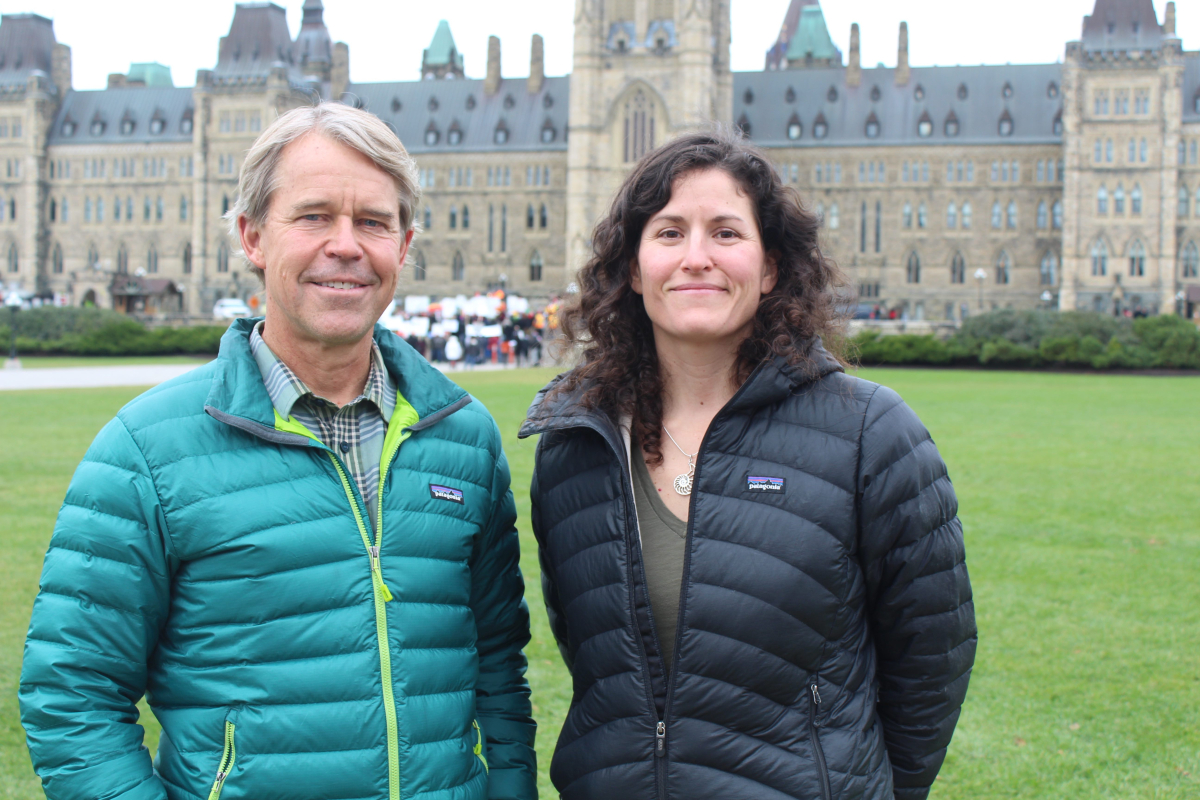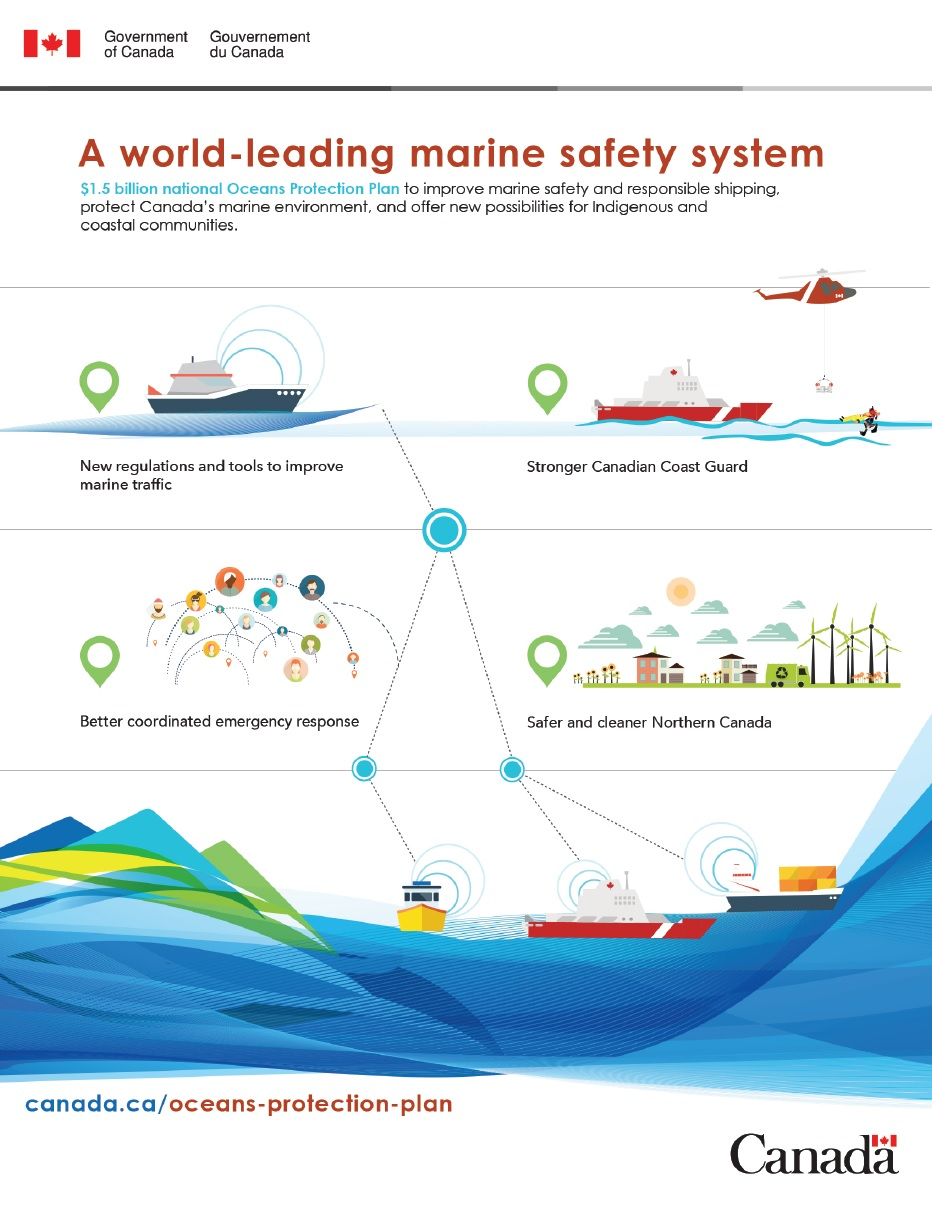Support strong Canadian climate journalism for 2025
Federal government officials spent two days denying the findings of a scientific paper exploring research into the effects of oilsands pollution in the ocean, a week before the Trudeau Liberals gave the green light to the Trans Mountain pipeline expansion to the west coast.
Records obtained by National Observer detail how the new study was sent, along with a letter, directly to Prime Minister Justin Trudeau. They also show how the references to scientific research would trigger immediate denials in a flurry of emails from officials within government.
The government has publicly said it is addressing the apparent gaps in science through a new federal plan to protect oceans, but it has yet to provide details.
Much of the newly-released internal correspondence occurred over two days in a critical period before the Trudeau government announced it was approving the Trans Mountain and Enbridge Line 3 pipeline expansion projects on Nov. 29, 2016.
The new evidence, released through access to information legislation, is coming to light as opponents of the major west coast pipeline are challenging the government's approval of the project at the Federal Court of Appeal.
The $7.4-billion Trans Mountain expansion project, proposed by Texas-based Kinder Morgan, would nearly triple the capacity of a network currently linking Alberta and British Columbia as well as expand a coastal oil terminal and tanker traffic on the west coast.
The Kinder Morgan pipeline has the blessing of the National Energy Board and the Trudeau government, and is backed by the Alberta government of NDP Premier Rachel Notley. Their governments have described it as a national priority that would create jobs and open up new markets for Canada's slumping oilpatch.

But the project has also infuriated some First Nations, cities and environmental groups worried about a range of issues such as oil spills, carbon pollution and Indigenous rights. B.C. Premier John Horgan's NDP government has joined in the opposition, pledging to use all tools available to protect the province's coastline from threats posed by the project.
The letter sent to Trudeau on Nov. 21, 2016 was based on an assessment of more than 9,000 pieces of scientific literature. This paper was authored by eight academics, peer-reviewed and published in a scientific journal, Frontiers in Ecology and the Environment.
“There are large unexamined risks to the marine environment from oil sands products,” the scientists wrote in their letter to Trudeau. The letter also told Trudeau that it would be “scientifically unfounded” to assume that damage from these products can be lessened.
Yet, some government officials quickly labelled the paper “wrong” and “not true,” picking apart its conclusions about industry secrecy, the availability of scientific data and the impact of the oilsands on climate change.
The internal correspondence also shows that an official inside Natural Resources Minister Jim Carr's office asked the department whether the study was accurate.
One week later, Trudeau and several cabinet ministers announced they had approved the Trans Mountain and Line 3 projects, but rejected a third pipeline, Enbridge's Northern Gateway project, based on “rigorous debate, on science and on evidence.”

'The science was thin'
The records provide an inside look into how the Trudeau Liberals are adhering to their 2015 election campaign promise to take scientific analyses into account when making government decisions.
Carr, present at Trudeau’s announcement, has also said that while there were “scientific opinions that don’t agree,” the government was “satisfied” the evidence that was available “in advance of this decision was good evidence and sufficient to make a good judgment.” Kinder Morgan has also said it has considered “the very best scientific and technical evidence” in developing Trans Mountain.
But the paper’s authors — led by Stephanie J. Green, a Banting fellow at the Center for Ocean Solutions at Stanford University in California, and including seven other academics in the U.S. and Canada — said they considered what studies have been published and what information is available about marine ecosystems and oilsands products, and have reached disturbing conclusions.
“What we have done is try to look in a comprehensive way across all publications that are widely available, and then draw conclusions about the amount of knowledge and information that can be brought to bear on these problems,” said Thomas D. Sisk, Olajos-Goslow professor of environmental science and policy at Northern Arizona University and one of the authors of the paper.
“Our research showed that the science was thin, and identified a bunch of troubling questions and concerns.”
The scientists stated in their letter to Trudeau that the approval of new projects in the area of Trans Mountain “is problematic, if not irresponsible given the lack of science needed to inform robust risk assessment.” There is “almost no publicly available scientific information” about how oil from the oilsands would react in the ocean, they added.
The paper also concluded that there were “administrative roadblocks” preventing scientists from studying oilsands products in the ocean. Bitumen, a tar-like heavy oil from Alberta's oilsands region, is too thick to flow in a pipeline, and so is diluted using a complex blend of hydrocarbons that may vary depending on a range of factors, including the outside temperature.
"The chemical composition of diluted bitumen," the scientists wrote in their paper, "produced and transported at a given time and place is a trade secret.”
Washington State officials have expressed similar concerns about a lack of information needed to respond to spills of diluted bitumen, National Observer reported in August.
Trans Mountain has said it is transparent about what it is transporting, noting that an industry website, crudemonitor.ca, provides a "full listing" of components for "each type" of crude product. The company didn't respond to questions from National Observer about the composition of the fuel it is currently transporting on its existing pipeline infrastructure and the composition of the fuels it plans to transport in the future.
That website is a widely-known source of information, but according to the Royal Society of Canada's 2015 expert panel report on the behaviour and environmental impacts of crude oil in water environments, it's "incomplete in scope and compositional information." A full spectrum analyses of components in heavy oils "are not available on this (crudemonitor.ca) website," it reads.

How much is diluted bitumen a trade secret?
Trudeau, his Cabinet ministers and others received an emailed copy of the scientific paper at 11:58 a.m. on Nov. 21, 2016, federal records show.
"I am excited to share with you the following new research," wrote Wendy Palen, another of the paper’s authors and an associate professor of the ecology of aquatic communities at Simon Fraser University in B.C., as she forwarded the study to Trudeau and his cabinet colleagues.
One of those that received that email was Carr’s director of policy Mike Rau, who emailed an assistant deputy minister in Natural Resources Canada, Frank Des Rosiers.
"Any truth to their claim that the composition of [diluted bitumen] is a trade secret — so that scientists cannot actually test it?" wrote Rau.
Des Rosiers had also emailed departmental officials, asking them to “prepare [a] quick response on this.”
Cecile Siewe, who is director-general at a federal government laboratory focused on fossil fuels and the oilsands, then wrote a lengthy email rejecting this finding.
“The composition of diluted bitumen is not a trade secret,” Siewe wrote, pointing to crudemonitor.ca as a source for "examples" of diluted bitumen composition and properties. Her lab, she added, has also received samples and has been “free to analyse, test (for example oil spill tests) and publish the results.”
Siewe said her lab colleague Heather Dettman, a bio-processing senior scientist, “was free to identify the diluted bitumen samples she worked on” at a presentation to the Arctic and Marine Oilspill Program, a forum where scientists and others working in the oil sector exchange information on oil spills.
Siewe then took aim at the way the "trade secret" summary statement was worded. It "implies there is only one kind of diluted bitumen," Siewe said, which she called “simply wrong” as there are several.
Scientists in government have also told National Observer they haven't studied all types of oil products shipped in Canada; Carl Brown, a scientist at Environment and Climate Change Canada, said in a December 2016 interview that the department was examining ones shipped at the highest volumes.
Asked if Siewe’s citation of crudemonitor.ca meant that the government of Canada considers the website to be a comprehensive, authoritative source, Natural Resources Canada spokeswoman Tania Carreira Pereira said the website illustrates "a source of readily accessible information" but that the site “is one of many sources of information” used by the government.
As well, one of the internal emails indicated that at least one company wanted to keep a secret about what it was transporting in a pipeline.
Siewe wrote that Environment and Climate Change Canada objected to a request in 2015 that the government sign a non-disclosure agreement (NDA) to protect the name of a company that supplied a sample of diluted bitumen that they were studying.
She said in the email that "a pipeline company asked that we agree to use generic names for the samples of diluted bitumen they supplied to us for our research."
That wasn't a problem for her team, Siewe wrote, because she said it didn't restrict their research or ability to publish. But Environment and Climate Change Canada did have a "significant problem" with the NDA "as they wanted to be able to identify the source of the diluted bitumen on their website."
Siewe called that situation "an exception" and said she was just flagging it "in case it comes up in subsequent discussions."
Natural Resources Canada still won't release the company's name, explaining to National Observer in an email that it can't do so because of the non-disclosure agreement it signed.

Anonymous analysis supports paper's findings
Whether diluted bitumen is a trade secret, however, was not the only problem departmental officials had with the scientific paper.
One day after receiving the letter, departmental policy adviser Thierry Spiess sent an email to his colleagues officials with more quotes that took aim at other points raised by the Canadian and American scientists.
Regarding the paper’s position that lessons learned from conventional oil spills aren’t sufficient, Spiess pasted in a quote from earlier that month, that the government has “sound information available” that would guide a co-ordinated response to a spill.
He also pushed back on the paper’s assertion that oilsands products contribute disproportionately to climate change, calling it “wrong in my opinion.” “I can get in touch with the authors if required…!?” he added.
“Thanks for this Thierry,” wrote back departmental official Douglas Heath. “It might be worthwhile if you could politely engage them as to their source,” referring to the paper’s conclusion about disproportionate climate change effects.
Large portions of the federal records released to National Observer were censored, so it’s unclear how extensively the departmental officials discussed the paper’s other findings. However, a separate analysis of the paper appeared in another undated and unauthored section of the records that were released.
This analysis — of which the department has declined to reveal its authorship or purpose in response to questions from National Observer — summarized the paper’s other key areas of concern, for example about coastal storage and marine transport of diluted bitumen and other oilsands products.
It supported the paper’s conclusions, stating that “more information is needed to understand what happens to the hydrocarbons that are larger than 40 carbons in both conventional crudes and diluted bitumen as the oils weather in marine environments.”
The analysis also added that the government would be studying how oilsands products degrade in the ocean as well as how oil toxicity in those waters changes over time. It said this research would be done under a federal Oceans Protection Plan, announced last fall.
Government won't say how much it's spending on spill research
Last week, Carr reiterated that the government's Oceans Protection Plan would address the threat of oil spills in the ocean.
The federal plan, estimated to cost about $1.5 billion over five years, was in "direct response to the interest on all of our coasts for the federal government to be very actively engaged in ensuring the safety of marine life," Carr said in a teleconference with media on Oct. 12.
"This is a serious commitment. We have had conversations with Indigenous communities, with the provinces, and we believe that this will make a significant difference, and it’s another way that the government of Canada is signalling that we have to talk about energy development and environmental stewardship at the same time."
The departmental analysis, however, didn't specify how much of the plan's overall money would be used for that specific purpose, and Natural Resources Canada also declined to provide this information when asked.
"Further details on specific [Oceans Protection Plan] initiatives will be released when available," wrote Pereira, from the federal department.
The department did confirm it will be collaborating with academia and non-governmental organizations to determine the toxic effects of oil on freshwater and salt water and the life contained within them.
Fisheries and Oceans Canada is also funding research "to better understand the biological effects of petroleum products on aquatic organisms," added Pereira.
National Observer also asked the department how it discussed the paper’s findings, whether and how Carr and his top advisers were shown the paper or informed of its findings before the Trans Mountain decision, and the authorship and purpose of the separate analysis revealed in the documents.
The department responded by writing in an emailed statement that the government's decision to approve Trans Mountain “was based on facts and science-based evidence.”
“We stand by these decisions because they are in the best interest of the country. We recognize that not everyone agrees with the decision made by the government, but we remain committed to working with provinces, territories, municipalities and Indigenous peoples to ensure a strong economy while taking leadership on the environment,” said the statement.
Meanwhile, Science Minister Kirsty Duncan steered clear last week from commenting on the science behind the Trans Mountain decision, even after the government appointed chief science adviser Mona Nemer.
Asked if she thought that if she had had Nemer in place when Trans Mountain was decided, the paper would have been flagged, Duncan said the question was “speculative” and refused to answer.

Scientist 'disappointed' in 'dismissal' of paper
Sisk, one of the paper's authors, said he was disappointed with the government’s response. “To me it sounded like they didn’t really need to worry about it, or consider it, and they decided to dismiss it,” he said.
“We know they discussed it, and they decided to ignore it, and then told the public that the science showed that the pipeline would be safe.”
He said he hadn’t had any contact with government officials about the paper. To his knowledge, none of the authors were consulted or contacted either, he said.
“If they dismissed [the paper’s findings], then I think in the interests of transparency there would be some counter to that, or the sharing of whatever information they – and only they – have access to, that would lead them to reach a different conclusion. I found it disappointing that they never provided that information,” he said.
He stressed, however, that by definition his paper did not include other information that the federal government or private business may have their hands on, as the paper was limited to publicly available, peer-reviewed literature, which he argued should be the standard for important policy decisions.
If the government has access to other scientific results, he said, "it would be helpful if that information was made public to a broader audience."
"I know that industry has proprietary information about their technologies and business practices, and there are many industry-funded studies and reports that have not been subjected to independent peer review," said Sisk.
Peter Hodson, a professor emeritus at the Department of Biology and School of Environmental Studies in Queen's University, who studies oilsands products and marine ecosystems but was not one of the paper's authors, echoed Sisk's statement.
“They’re correct to point out that there’s not a lot of research done on marine systems. That doesn’t mean research isn’t being done, but it hasn’t been published yet,” said Hodson.
Hodson is one of the authors of the 2015 Royal Society of Canada report. He also pointed to work done at the U.S.-based National Academies of Sciences, Engineering, and Medicine on diluted bitumen spills from pipelines.
That U.S. study gained public attention in Canada when it was rejected by the National Energy Board as potential late evidence when it was deliberating on the Trans Mountain expansion.
Hodson also argued that some research publicly available can be applied to the study of oilsands products in oceans, even if the research doesn't perfectly line up. He said the scientific paper should have given greater perspective about this.
“There’s some flaws in the paper, and I just find it a little hard to get excited that we haven’t got all the information that they think should be on the table to make a decision,” he said.
“When in fact, there’s a huge amount of information out there which is transferable, and it’s not going to give you a precise estimate of [diluted bitumen] toxicity in any given circumstance, but it’s going to give you a good ballpark.”








Comments
Great article. Based on the evidence provided, my federal court brain would not allow the KM expansion to go ahead. In fact, I might just shut down the existing pipeline. No more tankers in B.C. waters. Trudeau is such a hypocrite. Wow, we'll kind of protect some of the the Great Bear Rainforest, but we'll accept the extinction of ocean mammals and other ocean life. A complete and total disrespect of our First Nations and their honoured and knowledgeable traditions.
The Burnaby Teachers Association, an intervenor in the Kinder Morgan pipeline hearing, asked Kinder Morgan in the second round of questions (NEB document A4G5S0)
"1. What chemicals will be used to transport the bitumen/oil to Burnaby?"
In its response, Kinder Morgan did not list any chemicals or otherwise provide useful information. Thus, they are evidently a secret.
The Burnaby Teachers Association, an intervenor in the Kinder Morgan pipeline hearing, asked Kinder Morgan in the second round of questions (NEB document A4G5S0)
"1. What chemicals will be used to transport the bitumen/oil to Burnaby?"
In its response, Kinder Morgan did not list any chemicals or otherwise provide useful information. Thus, they are evidently a secret.
Mr trudeau's government is not any different than all previous government's when it comes to ignoring or dismissing reports scientific or otherwise which is not favorable to their agenda
All the more reason for Premier Horgan to do some real research into learning what happens when TAR meets Salt Water,
Good article National Observer. How can you get this out to the wider Canadian public? Push, push, push at every lever you have. Canadians need to know that Science is being ignored even while the Gov't claims otherwise.